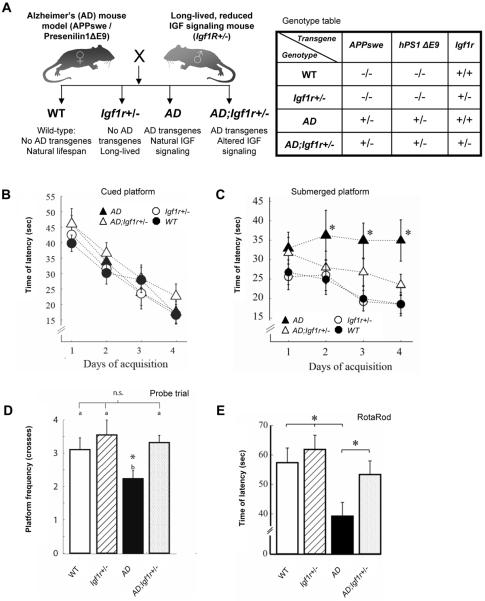Figure 1.
Reduction of IGF signaling protects mice from Aβ associated behavioral impairments. A. Long-lived mice carrying one Igf1r copy were crossed with transgenic Alzheimer's disease (AD) model mice harboring two AD-linked mutated genes, APPswe (containing the human Aβ sequence) and PS1ΔE9 to obtain offspring of four genotypes: (i) Wild Type – harbor two Igf1r copies and no AD linked transgenes (WT). (ii) Long-lived mice with one Igf1r copy and no AD linked transgenes (Igf1r+/−). (iii) AD model mice with two Igf1r copies and both AD-linked transgenes (AD). (iv) Mice that harbor only one Igf1r copy and both AD-linked transgenes (AD;Igf1r+/−). B. Latency time for reaching the cued platform significantly decreased through the acquisition sessions (P= 0, F = 35.49, df = 3) without differences between the four genotypes (P>0.05, F = 1.84, df = 3, n=8, 15, 16, 18 for AD, AD;Igf1r+/−, WT and Igf1r+/− respectively), suggesting no impairment of learning. C. For the submerged platform test significant differences were observed between genotypes (P = 5E-4, 2-Way-ANOVA, F=7.71, df = 3,) and across the acquisition days (P = 0.032, F = 2.97, df = 3, n=8, 15, 16, 18 for AD, AD;Igf1r+/−, WT and Igf1r+/−, respectively). The AD mice spent a longer time (P<0.05. Fisher-LSD) after the second day in order to find the submerged platform while no difference was observed among the three other genotypes. D. Analysis of the number of crosses of the previous platform location indicated that AD;Igf1r+/− animals crossed significantly (P=0.024, Kruskal-Wallis, χ2 =9.38, df = 3) more times than their AD counterparts. E. We analyzed the performance of individuals after the age of plaque formation (i.e. 12–16 month) in a Rota Rod task. Animals of the different genotypes significantly differed in their performance (P < 0.01, one-way ANOVA, df = 3, F = 4.25; n = 31, 32, 29 and 28 individuals for AD, AD;Igfr+/−, Igf1r+/− and wild type, respectively). AD mice performed worst among the four genotypes while AD;Igfr+/− mice where partially rescued from this impairment as they performed significantly better than AD animals (p < 0.05, Tuckey's LSD). Yet no statistical difference appeared between this later genotype and the two other control genotypes. In all behavioral tests, 11–15 month old mice were tested and age match controlled.

